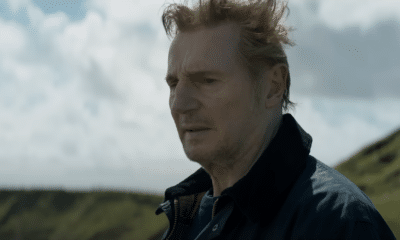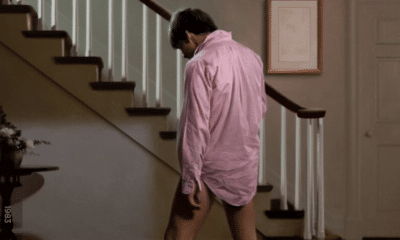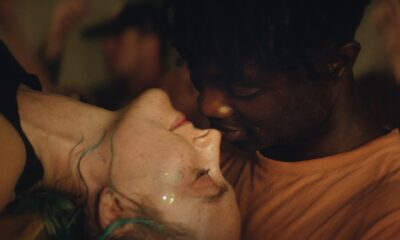Cut THN in half and you’ll see we’ve got Dredd running through us like the stick of Brighton rock we jammed in our anus to get ourselves off whilst reading ‘2000 AD’. Yes indeedy, THN makes no boners about it’s love of all things Judge Dredd (we’ve even got a soft spot for Stallone’s 1995 debacle, panned by critics, fan boys, Sly himself, and all forms of microbial bacterium lying dormant under the arctic tundra). Since Hollywood went gaga for comic book adaptations at the dawn of the second millennium we have waited patiently for Dredd to get another bite of the cinematic cherry. I mean, for goodness sake, we’ve sat through multiple incarnations of THE HULK, a pointless SPIDER-MAN reboot, misfires like DAREDEVIL, and box-office atom bombs like JONAH HEX, leaving us gawping in disbelief that no one has had the sense to see that Judge Dredd is a character gooey with potential…
But then in 2008, our hours of worship at our Dredd-shrine paid off, as DNA Films announced a new movie was in the works. DROKK YEAH!
With a desire to break into bigger-budget genre franchises, the UK indie production company cleverly recognised this fringe character had just the right amount of cult appeal and originality, and had the makings of a breakout hit. THN has seen the film (check out our review here) and can report that, whilst it will likely narc some of the comic’s die-hard fans, DREDD 3D is a brutally brilliant film that has the feel of a violent 1980s exploitation piece. With the film gore-ishly splattering onto cinema screens this week, THN went into incognito stealth mode, and (utilising nothing more than the freakish strength and cunning possessed by only the most ardent of stalkers) cornered the film’s star Karl Urban and writer Alex Garland to get their thoughts on the character of Dredd, broken bones (both on-screen and on-set) and the future possibilities of the DREDD franchise…
THN: Karl can you tell us how you got the role of Judge Dredd?
KU: I was actually on holiday with my family and got an email from my agent saying they’re rebooting Judge Dredd – any interest? Having been an avid reader of the comic when I was 17 I said ‘Yes!’ I got sent the script by Alex [Garland] and I thought that it was not only honorable to the source material but a wonderful action-packed character-driven story.
As a Dredd fan, and given the previous movie incarnation, were you wary of what type of film DNA wanted to make?
KU: We met in LA and had a frank and open discussion about the script and the character. I had a sense that they wanted to be assured I wouldn’t get halfway through the film and suddenly start demanding scenes without the helmet. I told them I wouldn’t even bother taking the meeting if I’d have read a script and found scenes where Dredd had removed his helmet – that’s not the Dredd I grew up reading and admiring, and I think that’s what sealed the deal….. Tonally you couldn’t be more different [to the 1995 Stallone version]… his film was a product of superhero films in the 1990s. Ours is a completely different take on it – it’s much more graphic, much more realistic, and I think in many ways it’s much more authentic to the character John Wagner created.
Alex, what was it that you liked about Karl for the role of Dredd?
AG: He got Dredd in a very deep way. I think like me he’d read the comic when he was younger, he knew Dredd, he understood it backwards. Karl sat down and said ‘I hope you’re going to do this and I hope you’re going to do that.’ He stepped forward and was saying these were his terms of which he’d be interested doing the character, and because we agreed it was a fantastic relief. Karl arrived fully formed – you didn’t have to give him notes.
Were you nervous about taking on such an iconic character with so much cult appeal?
KU: It represented a huge challenge. For me I was focused on doing my job and that’s delivering the most specific and interesting multidimensional character I can. Other people’s expectation of what that is going to be is outside my area of concern – I’m just focused on what my job is. And certainly having been a fan since I was a teenager I put a lot of pressure upon myself to get it right.
AG: My intention from the get–go was not to re-invent Dredd, but to do it in a way that did justice to the character of the comic books. The first thing I did was to contact John Wagner [the writer and co-creator of Judge Dredd] to bring him in, not as a way of name checking the creator, but I wanted him to actually be working on the film as a proper paid part of the team, which he was. He would always be there to keep track of his character and make sure we were doing it right. I would always send him drafts, he would change lines and I would accept the changes happily.
What was the essence of Dredd’s character you wanted to present in this movie?
AG: I wanted the film to have a relentless hardness – that’s part of the character whose story I want to tell. It’d be easy to try and humanise Dredd, but he’s already a human, he’s not a superhero, he’s just a man and he can’t do anything that a normal man can’t do. But people try to humanise him. They want to contact him more, but John Wagner said to me ‘The harder you make him, the more they’ll love him,’ and I chose that as a maxim and I’ll always remember that.
KU: The thing that sets Dredd apart is that he’s not a superhero. He doesn’t have super-powers all he’s got is an extraordinary skill set, a versatile gun and a really cool bike. What was really important to me was that this was not going to be a bombastic character based in ego. We wanted the character to be like a tightly wound spring – to me it’s far more interesting to watch a character struggling to contain his rage at the injustice than letting it out so that’s what we were going for… he is the type of guy going into a building when everyone else is coming out and to me that’s the definition of a real hero – he’s just a man doing a job.
DREDD 3D is ultra-violent. Was making a hard 18-rated movie something that appealed to you?
KU: I have to say that I underestimated a lot of the graphic elements. When you read something on the page your imagination does the work but it’s something else when you see it fully realised. Even whilst making the film I wasn’t quite aware of some of the more graphic elements and when I sat down and watch it, it made me recoil. The violence becomes a character and really informs the audience about the reality of what it’s like for these Judges operating in this world where there is very little regard for human life. We’ve seen a lot of Hollywood movies that are BANG-BOOF- POW-VIOLENCE! But you don’t really understand what has occurred – but because we have this narrative element called Slo-Mo you get to see everything from this perspective and really get to explore it.
We understand you went through extensive training for riding the bike and handling the weapons, do you like to do as much of your own stunt work as possible?
KU: Sometimes it’s best to hand these things over to the experts because things can go wrong – and they certainly did go wrong on our film. There is one particular sequence where our stunt doubles had to jump out of a building onto a skate park and it was deemed to be too dangerous for Olivia and myself to do. I looked at it and said ‘C’mon, I can do that!’ and they’re like ‘I don’t think so’. So our doubles did it and on the very first take Wood Harris’ double landed incorrectly and he compound fractured his leg! That means the bone came through the skin! Completely dislocated his hip –so sometimes it’s just best to hand those things over to the professionals.
What was it like working with an up-and-commer like Olivia Thirlby?
KU: Olivia is an extraordinary actress and she does an amazing job on this film. We formed a real partnership, we both realised that we needed each other and because it’s a character driven film and that relationship’s evolution is really the core of this film – it’s the glue. Dredd doesn’t think much of her in the beginning but that changes and you enjoy spending time with these characters. Everyday Olivia and I got together before we started shooting and would discuss the day’s work to make sure we were on the exactly the same page to really define the beats we wanted and we formed a really solid partnership that I think the movie really benefits from.
Is it fair to say that a lot of the movie is about the development of Thirlby’s character; Judge Anderson?
AG: The standard set up with a film is that a character goes on a big journey and they change a lot – Dredd couldn’t do that. He’s not about change, that’s not what he is. I see him like a glacier and a desert – a glacier because he moves very slowly and a desert because if there’s one thing in a desert you focus on it so if he tilts his head you put all this extra meaning on it. I always knew that at the heart of this film Dredd would be like a rock that hardly moved so the traditional story arch stuff , that’s Anderson’s journey and that’s intentional so somebody is traveling at least at that accelerated pace.
Certain stylistic elements such as the look of Mega-City One are quite a departure from the comics are you worried some fans will be upset?
AG: The approach to the city is the same as the approach to the uniform – if you do a very faithful adaptation of the uniform – you’d have someone that if they got stabbed in the stomach they’d be in big trouble. Dredd is out there on the front line so he needed protection. I guess the way I saw the city was a place that doesn’t have money falling out of itself – its got very high unemployment, the blocks are like 1950-60s tower blocks built in a functional utilitarian way to house as many people as possible. They don’t have architectural flourishes because they’re about housing and lack of money. So that dictated an aesthetic.
So realism underlines every stylistic decision?
AG: It does, and I would say that’s DNA house style – I think you can see that aesthetic in 28 DAYS LATER or SUNSHINE that there is weird stuff but there is also real stuff.
We’ve heard that early scripts involved characters like Judge Death and other elements directly taken from comic story arcs but weren’t workable – might these be elements fans get to see in potential DREDD 3D sequels?
KU: I have not read those drafts – I’d be interested to though. The truth is we’ve just spent so much time and energy focusing on this film and now we’re just releasing it. I would love to come back and make more of these. I’ve had such a great time working with Alex and the whole team, if we get to make more that would be fantastic. But if this is a one off cult classic, I am genuinely happy with it. If this is just a one off then I’m okay with that.
AG: We’ve got a film that hasn’t yet been released and a sequel certainly isn’t more possible yet – it may be in four weeks’ time. It’s a really big if – it’s an 18-rated film and in order to generate the kind of money it would need to make to justify a sequel is a tall order. That said, if I was able to work on a sequel there are definitely particular stories I would like to tell. A second film, broadly, would evolve characters like Chopper, story lines like ‘Origins’, ‘Cursed Earth’, and it would be about Dredd’s history and the history of the city which are bound up in each other. And it would involve the weird deal between the fact that he’s a fascist and terrorists are pro-democrats and he’s an anti-hero. It’s a complex situation, so I’d love to try that… and after that, if the films went any further it would be the crazier stuff, which for me would be Judge Cal and the Dark Judges.
Exciting stuff…would your involvement be conditional that Karl returns as Dredd?
AG: It’s hard to say about future projects that don’t exist. But I personally couldn’t imagine anyone else doing it. It was such an easy thing to get wrong, people probably misunderstand what he’s doing It’s a very controlled performance – it really is.
DREDD 3D is out in cinema 7th September and is well worth a watch.
A BA in Media & an Art MA doesn’t get you much in today’s world – what it does give you however is a butt-load of time to watch a heck of a lot of movies and engage in extensive (if not pointless) cinematic chitter chatter. Movies and pop-culture have always been at the forefront of Joe’s interest who has been writing for THN since 2009. With self-aggrandised areas of expertise including 1970s New Hollywood, The Coen Brothers, Sci-Fi and Adam Sandler, Joe’s voyeuristic habits rebound between Cinematic Classics and Hollywood ephemera, a potent mix at once impressively comprehensive and shamelessly low-brow.

Latest Posts
-


Film Reviews
/ 9 hours ago‘In The Land Of Saints and Sinners’ review: Dir. Robert Lorenz (2024)
The film is released on Netflix this week.
By Paul Heath -


Home Entertainment
/ 16 hours ago‘Risky Business’ and ‘Blow Out’ are getting the UK Criterion treatment
Risky Business and Blow Out will be released on UK Criterion 4K Blu-ray this...
By Paul Heath -


Film News
/ 16 hours agoRelease date announced for ‘The Outrun’ with Saoirse Ronan
After premiering at this year’s Sundance and the Berlinale in Germany, the UK release...
By Paul Heath -


Apple TV
/ 2 days agoTrailer: André Holland leads Apple’s new limited series, ‘The Big Cigar’
Apple TV+ has released the full trailer for The Big Cigar, a new, six-episode...
By Paul Heath
















